Council
Elisabete Martins
10th Jean Paelinck Seminar of Spatial Econometrics, October 24-25, 2019, University of Zaragoza, Spain
10th Seminar Jean Paelinck
http://dae.unizar.es/10thseminarjp
On behalf of the Organizing Committee, we are pleased to invite you to Zaragoza (Spain) to the 10th edition of the Seminar of Spatial Econometrics in honor of Professor Jean Paelinck. The Seminar will be held in October 24-25, 2019.
The conference aims to provide a forum for debate between young and senior researchers and it is open to both theoretical and applied papers, which deal explicitly with questions of spatial statistics and econometrics. Welcomed contributions are related with the topic of the seminar: Spatial Big Data. Contributions dealing with other topics are also welcomed.
A workshop on Web scraping with R will be held for participants in the seminar.
PHD STUDENTS
To encourage the participation of young researchers, the GAEC group offers 2 grants for PhD students, which include free registration and accommodation. A selection process will be carried out to select the best two papers among applicants.
Paper submission for Ph.D. Students: July 25, 2019
CONFIRMED KEYNOTE SPEAKERS:
Dr. Giuseppe Arbia. Università Cattolica del Sacro Cuore
Dr. Javier Gutiérrez. Universidad Complutense de Madrid
Dr. Javier J. Pérez. Bank of Spain
Important dates
Abstract submission: July 25, 2019
Full paper submission: September 8, 2019
Notification of acceptance: September 22, 2019
Registration: October 13, 2019
You are invited to submit your paper or abstract to the following email address:
This email address is being protected from spambots. You need JavaScript enabled to view it.
More information concerning the workshop is available at:
REMINDER | Call for Abstracts | 26th APDR Congress, 4-5 July 2019, Aveiro, Portugal
Call for Abstracts
It is our pleasure to announce the 26th APDR Congress, to be held at the University of Aveiro, Portugal, from July 4 to July 5, 2019.
Theme of the Conference:
Evidence-based territorial policymaking: formulation, implementation and evaluation of policy
Keynote Speakers
|
FEP e Quaternaire |
Universidade de Aveiro |
University of Cambridge |
ICS-ULisboa |
Universidade de Aveiro |
University of Michigan |
The call for abstracts are open and your participation is very welcome!
Deadline for Abstracts submissions: April 16, 2019. Abstracts should be submitted electronically, using the platform available on the Conference website: https://events.digitalpapers.org/apdr2019
All information at the congress website: http://www.apdr.pt/congresso/2019
Looking forward to meeting you in Aveiro!
The Organizing Committee and the Board of APDR
26th APDR Congress
ERSA congres 2019 : Special Session ”Serious Games and Urban Studies”
Dear Colleagues,
We would like to bring your attention to the following Special Session which we are organizing on: ”Serious Games and Urban Studies”, on behalf of the 59th congress of the European Regional Science Association (27 - 30 August 2019, Lyon, France).
Convenor(s): Arnaud Banos (Géographie-cités), Jean Debrie (Géographie-cités), Mathieu Gardrat (LAET), Olivier Klein (LAET), Nathalie Molines (AVENUES-GSU)
See more details on congress themes here : Congress Themes
Submission portal Sign In : Submission portal Sign
Important dates: Deadline for submission of abstracts (and) papers : Extended deadline to March 15th, 23.59, GMT+1
Serious games have been used for many years in education and training, and now have an increasing role in our society. The vast potentials of this medium are now taking shape for various audiences, situations and subjects: healthcare, environment, communication, politics, corporate, defense, etc. Cities also appear to be an ideal playground for serious games. Gamification allows rendering the complexity of the urban system into understandable and playable processes for a wide public. This gamification however raises many questions concerning its role for research and the knowledge of the urban system, as well as for practitioners, such as:
- Data collection and analysis : methods to improve knowledge with games (behaviours, interactions)
- Prospective and scenario calibration: how actual urban stakeholders can help defining scenarios through games?
- Simulation: how games allow modelling(stakeholders’ interactions, land use and transport interactions...)and produce exploitable results?
- Education, training and awareness: helping outreach and dissemination of researches
- Consultation and mediation on specific subjects.
Other uses might of course be of use to researchers. The process of gamification itself also questions the adaptation of theories into practices and their validity. The goal of this session is therefore to discuss the experiences, uses and potentials of city-themed serious games in the field of academic research.
For additional information please contact:; This email address is being protected from spambots. You need JavaScript enabled to view it.
Best regards,
Arnaud, Jean, Mathieu, Nathalie and Olivier
Conference on “Institutions, Governance and regional development”, 5-6 September 2019, Yerevan State University, Armenia
The Conference on the topic “Institutions, Governance and Regional Development” will be organized by Caucasus Association of Regional Science and will take place in Yerevan, Armenia, from 5th to 6th of September 2019, at the Yeravan State University.
This Conference aims at providing a scientific platform for academics and young researchers interested in spatial economics and planning, regional and local development and related issues. That creates unique opportunity of networking and exchanging ideas on ongoing research in the field.
Deadline for the application is 31th July 2019.
More information at: https://rsai64.wixsite.com/yerevan2019
Conference on “Institutions, Governance and regional development”, 5-6 September 2019, Yerevan State University, Armenia
The Conference on the topic “Institutions, Governance and Regional Development” will be organized by Caucasus Association of Regional Science and will take place in Yerevan, Armenia, from 5th to 6th of September 2019, at the Yeravan State University.
This Conference aims at providing a scientific platform for academics and young researchers interested in spatial economics and planning, regional and local development and related issues. That creates unique opportunity of networking and exchanging ideas on ongoing research in the field.
Deadline for the application is 31th July 2019.
More information at: https://rsai64.wixsite.com/yerevan2019
Call for Abstracts | 45th AECR Conference | 20-22 November 2019, Castellón de la Plana, Spain
Dear colleagues,
The abstract submission for the XLV Meeting of Regional Science and the VI Valencian Conference of Regional Science, which are organised by the Spanish and Valencian Associations of Regional Science, is open. The Conference will be held at University Jaume I (Castelló), from 20th to 22nd of November, 2019, with the organizative support of the Interuniversity Institute of Local Development.
The motto for the Conference is “Tackling with societal, technological and climate changes in peripheral territories”. The sessions of the Conference will include a wide range of topics, which will be grouped in 20 subject areas and special sessions. We are pleased to announce that the Professor Raquel Ortega Argilés (University of Birmingham) and the Professor Jérôme Vicente (Université de Toulouse) will join the Conference as keynote speaker.
Abstracts should be no longer than 300 words and uploaded to the members’ area before May 15th of 2019 using the attached template. As well as the previous years, you will be able to submit the results of an ongoing research even if it is not a complete paper yet. The Scientific Committee will consider the acceptance of this kind of work through the submission of a long abstract, which should have a minimum extension of 1,500 words. The template of abstract and further information about the Conference are attached.
Unpublished papers written by researchers of an age under 33 years and presented at the parallel sessions are eligible for the Juan Ramón Cuadrado Young Researchers’ Prize. The jury that will grant the Prize is the Scientific Committee of the Conferences. The authors of the paper awarded with the prize will receive an accreditation for the award and a gift.
PhD students in the first stages of their dissertations and master degree students with a research orientation will enjoy reduced registration fees that will let them access to the parallel sessions of the Conference, and participate in the special session for young researchers also. There, they will present briefly their research ideas, preferably through posters.
We are looking forward to your participation and we hope to have the opportunity to welcome you at Castelló.
Greetings,
The Local Organizing Committee
European International Conference on Transforming Urban Systems (EICTUS-2019) Strasbourg - France
European International Conference on Transforming Urban Systems (EICTUS-2019)
26 – 28 June 2019
Université de Strasbourg, France
https://eictus-2019.sciencesconf.org/
CALL FOR ABSTRACTS – Submission deadline 15 March 2019
Dear Colleagues,
On behalf of the “Zone Atelier Environnementale Urbaine (ZAEU)” Université de Strasbourg - France, we are highly delighted to invite you to submit your abstract and participate in the European International Conference on Transforming Urban Systems (EICTUS-2019), which will be held from 26 – 28 June 2019 at Université de Strasbourg, France.
Major conference themes are as under:
• Sustainable cities
• Urban metabolism and sustainability
• Urban ecology and eco-services
• Urban land-use, development and planning
• Urban climate, risks, resilience, vulnerabilities and adaptation
• Energy resources, sustainable urban energy productions and supplies
• Urban mobility, sustainable and innovative urban transport systems
• Urban pollutions (air, water, soil) and reduction strategies
• Urban risks, remediation and protection strategies
• Urban economy and cost-effectiveness strategies
• Other inter-disciplinary topics related to urban transition
Abstract submission: You are warmly invited to submit a 300 to 500 words summary of your work on or before 15 March 2019.
For further details, please visit the website of the conference: https://eictus-2019.sciencesconf.org/
We warmly invite you in the incredibly diverse city of Strasbourg for a stimulating and enjoyable EICTUS-2019 to share the knowledge and to learn and develop the network for future research.
With best regards from France,
Dr. Nadège BLOND
Conference Chair
Dr. Sandrine GLATRON
Directrice ZAEU
Dr. Sajjad Hussain SAJJAD
Organizing Chair
Call for Nominations for the Election of the President of the Regional Science Association International 2020-2021
Dear Members of the Regional Science Association International,
Following the Constitution of our Association, in 2019 RSAI is expected to elect its President Elect, due to succeed to Mark Partridge from 2021. According to By-Law 5.a:
“The RSAI President shall be elected by the Council for a two-year term and confirmed by a vote of the entire active membership of the Association. To canvass suitable candidates for nomination, the Council establishes a “Nomination Committee” comprising the RSAI President, the RSAI Immediate Past-President, three members of the RSAI Council (one each from among the council members who are appointees of the three superregional organizations), and two members of the Long Range Planning Committee (LRPC) recommended by the LRPC itself”.
The Nomination Committee has been nominated at the RSAI Council meeting in San Antonio, and is composed by Mark Partridge (Chair), Budy Resosudarmo, Neil Reid, Rachel Franklin, André Torre, Eduardo Haddad, Geoffrey Hewings, and Kingsley Haines. The committee proposed the Executive Director to launch this Call for Nominations of Candidates for the Election by the RSAI Council of the President of the Regional Science Association International 2021-2022.
RSAI members from LARSA who wish to propose their candidature for the Presidency of the Regional Science Association International may submit their proposal to This email address is being protected from spambots. You need JavaScript enabled to view it. within May, 15th 2019. Candidatures should contain the following documents:
- A two-page CV and a Picture;
- A two-page statement on the motivations for applying as RSAI President and a discussion of the plans for the future strategy for the RSAI.
The Nomination Committee will then nominate the candidates to be voted on-line by the Members of the Council. Results will be diffused through RSAI News and on the RSAI webpage.
Best regards,
Jönköping International Business School (JIBS) is looking for up to three doctoral students in economics
JIBS is one of four schools within Jönköping University. We offer an international and team-oriented workplace with competitive education programs, across bachelor, master and doctoral levels, as well as a thriving research environment and many opportunities for personal development. JIBS has three guiding principles: international at heart, entrepreneurial in mind and responsible in action. Our mission is to advance the theory and practice of business, with specific focus areas in entrepreneurship, ownership and renewal. At JIBS, we have the following research centers: Center for Entrepreneurship and Spatial Economics (CEnSE), Center for Family Enterprise and Ownership (CeFEO), and Media, Management and Transformation Center (MMTC). As a doctoral student you have the option to be affiliated with one or more of these centers.
Economics is one of the largest disciplines at JIBS and is globally known for excellence in research and teaching and for its strong international profile. Current strengths in research in economics at JIBS include (i) innovation, entrepreneurship, industrial dynamics and growth, (ii) urban and regional economics, (iii) international trade, (iv) labor market outcomes, (v) firm dynamics, (vi) development economics, and (vii) corporate governance, firm performance and institutional conditions.
For more information about research at JIBS, please visit www.jibs.se, where you can also read more about our PhD program.
Working tasks
We offer a full-time position that is fully financed. Most of your time will be devoted to your doctoral studies (80%) which includes coursework (120 credit points, ECTS) and writing a doctoral thesis (120 credit points, ECTS). The course work includes both mandatory courses in macro- and microeconomics, econometrics, and classics in economics, and elective courses depending on the topic of your thesis. The remaining time (20%) is allocated for teaching and administrative tasks. There are also opportunities to take additional courses in pedagogics for higher education.
As a doctoral student you will work independently as well as in teams.
Qualifications
As an applicant you should hold a master’s degree in economics or have acquired the corresponding knowledge in some other way, by the time the employment starts. The applicant is required to have at least 90 credit points in economics and at least 15 credit point in statistics (or the equivalent). The main language of research and teaching at JIBS is English. You must be fluent in both written and spoken English to be eligible for our doctoral program.
Prior research, teaching and/or professional experience are meritorious, as is an ability to communicate effectively with different stakeholders in and around the university environment. We seek candidates who have the ambition to pursue an international research career and wish to combine a high level of scholarship with policy-making and/or practical relevance.
For more information: https://ju.mynetworkglobal.com/se/what:job/jobID:253565/where:4/.
ERSA2019 Call for Abstracts (and) papers: Submit now!
|
About Us
The Regional Science Association International (RSAI), founded in 1954, is an international community of scholars interested in the regional impacts of national or global processes of economic and social change.

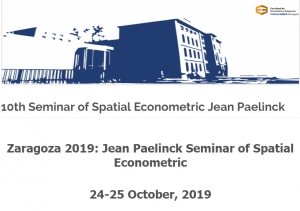
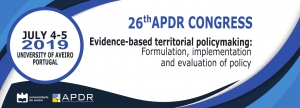






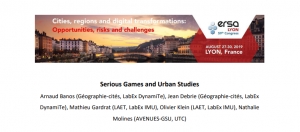
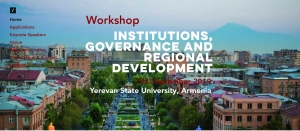
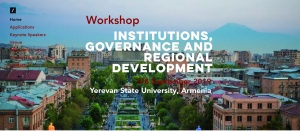
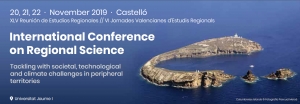


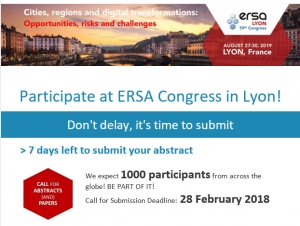

 We expect 1000 participants from across the globe! BE PART OF IT!
We expect 1000 participants from across the globe! BE PART OF IT!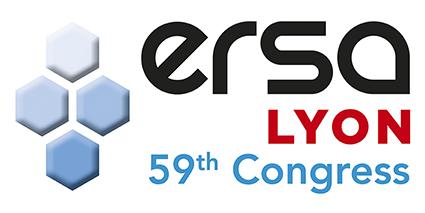
 Join us on Twitter
Join us on Twitter 